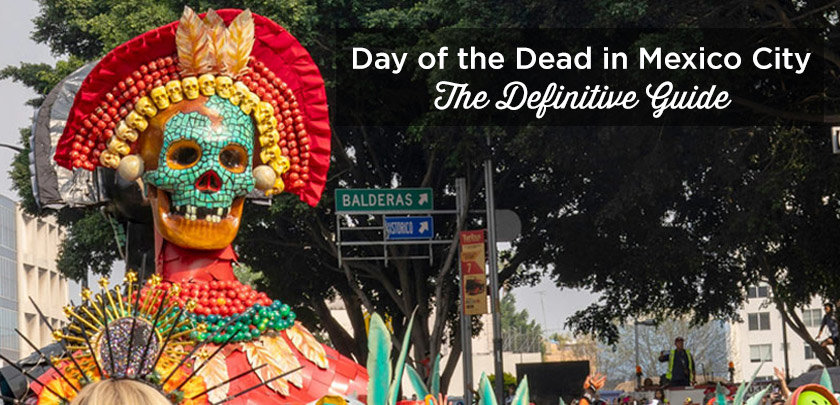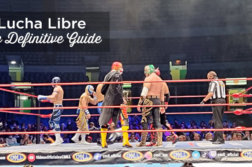How to Celebrate Day of the Dead in Mexico City 2025: All the Best Things to Do and See
Planning to experience Día de Muertos in Mexico City during your trip to Mexico?
Great idea!
The Day of the Dead is one of Mexico’s most iconic and meaningful traditions—so much so that it’s been recognized by UNESCO as Intangible Cultural Heritage of Humanity.
But keep in mind: it’s also one of the busiest times of the year in Mexico City, drawing thousands of visitors. That’s why it’s essential to plan ahead to make the most of your stay and avoid missing out on key events.
In this complete guide, I’ll show you what to do in Mexico City during Día de Muertos: where to see the most beautiful altars and cemetery tributes, which neighborhoods to explore, where to try the best pan de muerto, and where to stay depending on your itinerary.
So, how do you celebrate the Day of the Dead in Mexico City?
Let’s find out!
Sommaire
- How to Celebrate Day of the Dead in Mexico City 2025: All the Best Things to Do and See
- 1. Why Experience Día de Muertos in Mexico City?
- 2. What’s the Day of the Dead Atmosphere Like in Mexico City?
- 3. Día de Muertos 2025: Key Dates and How Long It Lasts
- 4. Top 10 Things to Do in Mexico City During Día de Muertos
- 4.1 The official Día de Muertos parade
- 4.2 The Great Catrina Parade
- 4.3 Join a Local Día de Muertos Tour in Mexico City (November 1)
- 4.4 Dive into the magic of Xochimilco
- 4.5 Visit San Andrés Mixquic: Mexico City’s Most Iconic Día de Muertos Cemetery
- 4.6 The Alebrijes parade
- 4.7 Discover the most spectacular altars
- 4.8 Discover Mexico City’s traditional markets
- 4.9 Visit museums with temporary exhibitions
- 4.10 Rodada Nocturna – nocturnal bike ride
- 5. Where to Stay During Día de Muertos in Mexico City
- 6. What to Eat During Día de Muertos in Mexico City (Typical Dishes)
- 7. Día de Muertos in Mexico: Words and Symbols You Should Know
- 8. Best Neighborhoods to Visit in Mexico City During Día de Muertos
- 9. Suggested Itineraries for Día de Muertos in Mexico City
- 10. Frequently Asked Questions About Día de Muertos in Mexico City
- 10.1 Is It Safe to Visit a Cemetery on Día de Muertos in Mexico City?
- 10.2 Can You Celebrate Día de Muertos in Mexico City With Kids?
- 10.3 Can You Visit a Cemetery During Día de Muertos in Mexico City?
- 10.4 What to Wear for Día de Muertos in Mexico City
- 10.5 Where to Buy Día de Muertos Decorations in Mexico City
- 10.6 Are There Free Día de Muertos Events in Mexico City?
- Rent a car in Mexico City
- How to find the best price for your flight ticket
- You’re traveling in Mexico? These articles will help you!
1. Why Experience Día de Muertos in Mexico City?
Mexico City is one of the best places to experience Día de Muertos, as the whole city rallies around the occasion.
Between the parades, spectacular altars, decorated markets, illuminated cemeteries and free cultural activities, there’s an authentic atmosphere.
Celebrating the Feast of the Dead in México City combines a visit to the capital with a cultural celebration unlike any other in the world. Mexicans are very warm-hearted and proud of their origins and traditions.
2. What’s the Day of the Dead Atmosphere Like in Mexico City?
From mid-October onwards, the streets of Mexico City are decked out in colors going from the orange of the cempasúchil (marigold flowers) to the purple of the decorations.
Music plays, people dress up as catrinas, restaurants and other public places are decorated with candles, the streets smell of copal, and the markets are decorated for the occasion.
It’s both festive and spiritual, and above all, very much alive.
It’s important to note that, despite the magnitude of this great festival, the capital remains densely populated and not all districts are fully decorated.
3. Día de Muertos 2025: Key Dates and How Long It Lasts
Día de Muertos in Mexico City is not limited to a single day. Although the festival culminates on November 1st and 2nd, celebrations often extend over several days – and sometimes even weeks!
Here are the key dates to remember:
- October 31: start of activities, installation of altars and first decorations
- November 1: Día de los Angelitos, dedicated to deceased children
- November 2: Día de los Fieles Difuntos, dedicated to the adults
But in Mexico City, the festivities often begin earlier, with the first altar displays, decorated markets, cultural activities and some parades taking place as early as mid-October.
I advise you to keep an eye out for official announcements from the end of September to make sure you don’t miss a thing!
4. Top 10 Things to Do in Mexico City During Día de Muertos
4.1 The official Día de Muertos parade
Inspired by the James Bond film Spectre (2015), this colorful procession was launched by the Mexican government and has quickly become a major event.
It brings together floats, dancers, mariachis, costumes and traditional music, from Puerta de los Leones in Chapultepec through Reforma Avenue to the Zócalo.
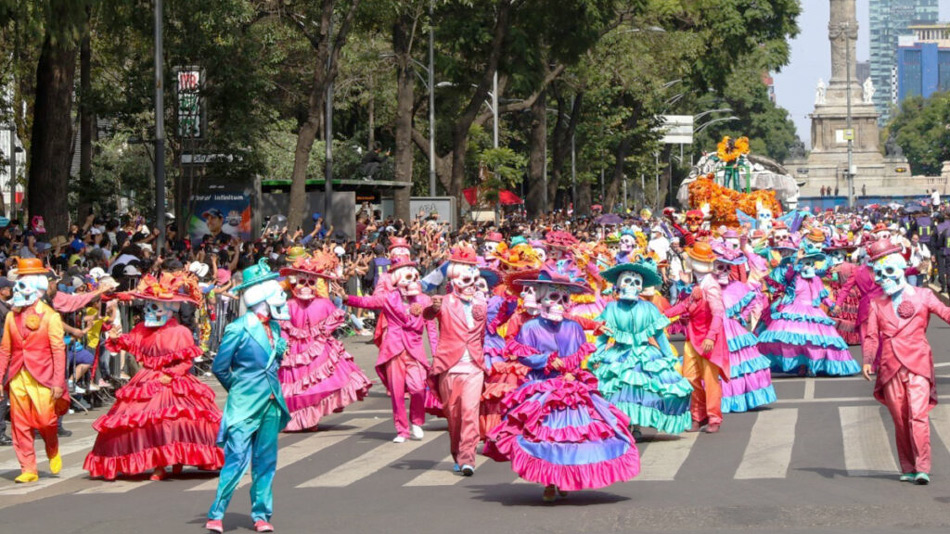
4.2 The Great Catrina Parade
The Catrina, Mexico’s elegant icon of death created by Guadalupe Posadas and popularized by Diego Rivera, takes pride of place in this parade where hundreds of participants march in procession between the Angel of Independence and the Zócalo.
A festive, colorful atmosphere, perfect for admiring the creativity of the costumes and taking memorable photos.
- This year, the Catrinas Parade will take place on October 26
These are quick and easy street make-ups. You can also buy flower garlands and other accessories typical of the season to complete your outfit. And Listo! you’re ready to see the parade.
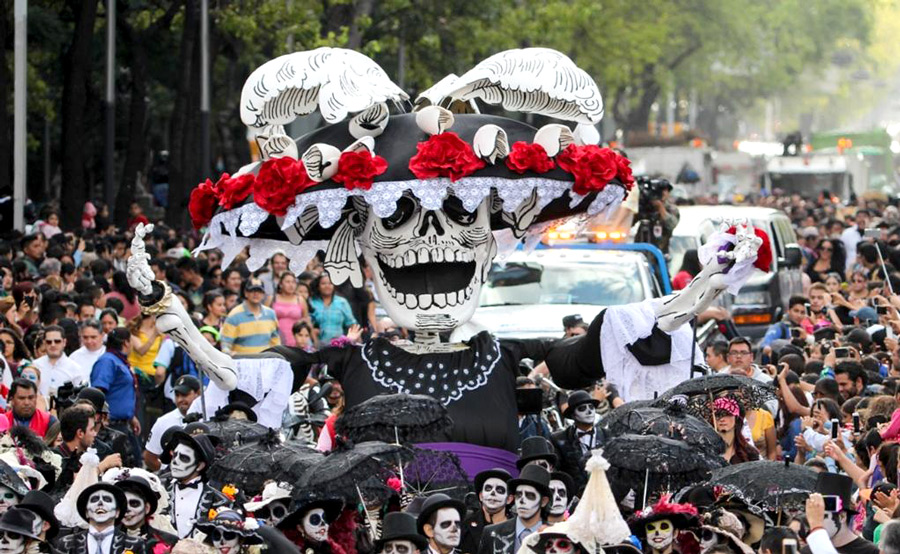
4.3 Join a Local Día de Muertos Tour in Mexico City (November 1)
There’s plenty to do in Mexico City during Día de Muertos, but the city can quickly become chaotic: distances are great and the main places to visit are often far apart.
If you prefer not to have to deal with transportation and organization, I recommend this guided Día de Muertos tour of Mexico City.
This unique experience, which only takes place on November 1st, immerses you in the mystical atmosphere of the capital: a panoramic tour of the illuminated monuments of the city center, a stop in a cemetery to discover the altars and rituals, and a night trajinera ride in Xochimilco, a day to be complete with Mariachi music!
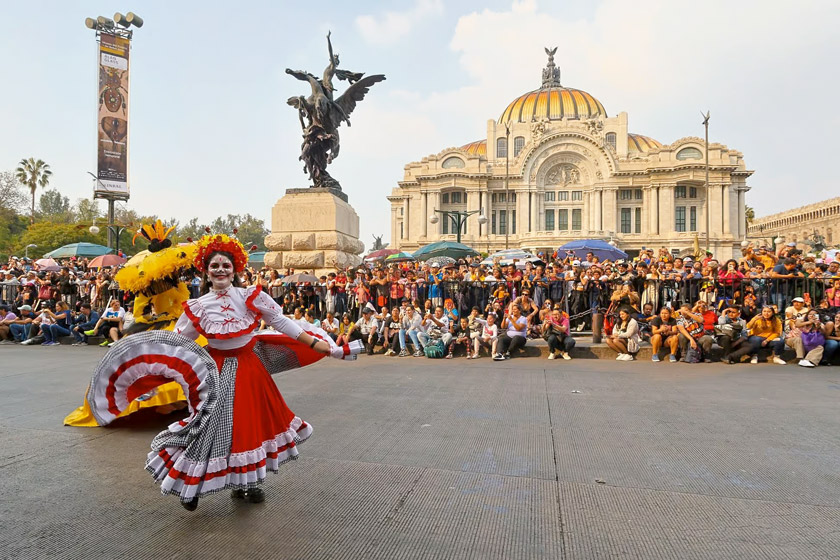
4.4 Dive into the magic of Xochimilco
A UNESCO World Heritage site, this emblematic district invites you to sail its famous trajineras (colorful boats) to the sound of traditional music and a unique festive atmosphere.
It goes without saying that Xochimilco is a must-see on any trip to Mexico City, but during the Festival of the Dead, it’s transformed!
The canals are lit up with candles, flower-filled altars pay tribute to the dead, and visitors can enjoy spellbinding shows such as La Llorona, a nocturnal theatrical performance on the water, combining legend, song and emotion.
For curiosity seekers, don’t miss the Isla de las Muñecas (Island of the Dolls), a mysterious place steeped in local history. And if you’re passionate about nature, you’ll be delighted to discover the ajolotes, the small endemic creatures that still inhabit the canals.
You’ll also find craft markets, beautifully decorated squares and fields of cempasúchils (the famous orange altar flowers) as far as the eye can see.
And don’t miss My Complete Guide to visiting Xochimilco!
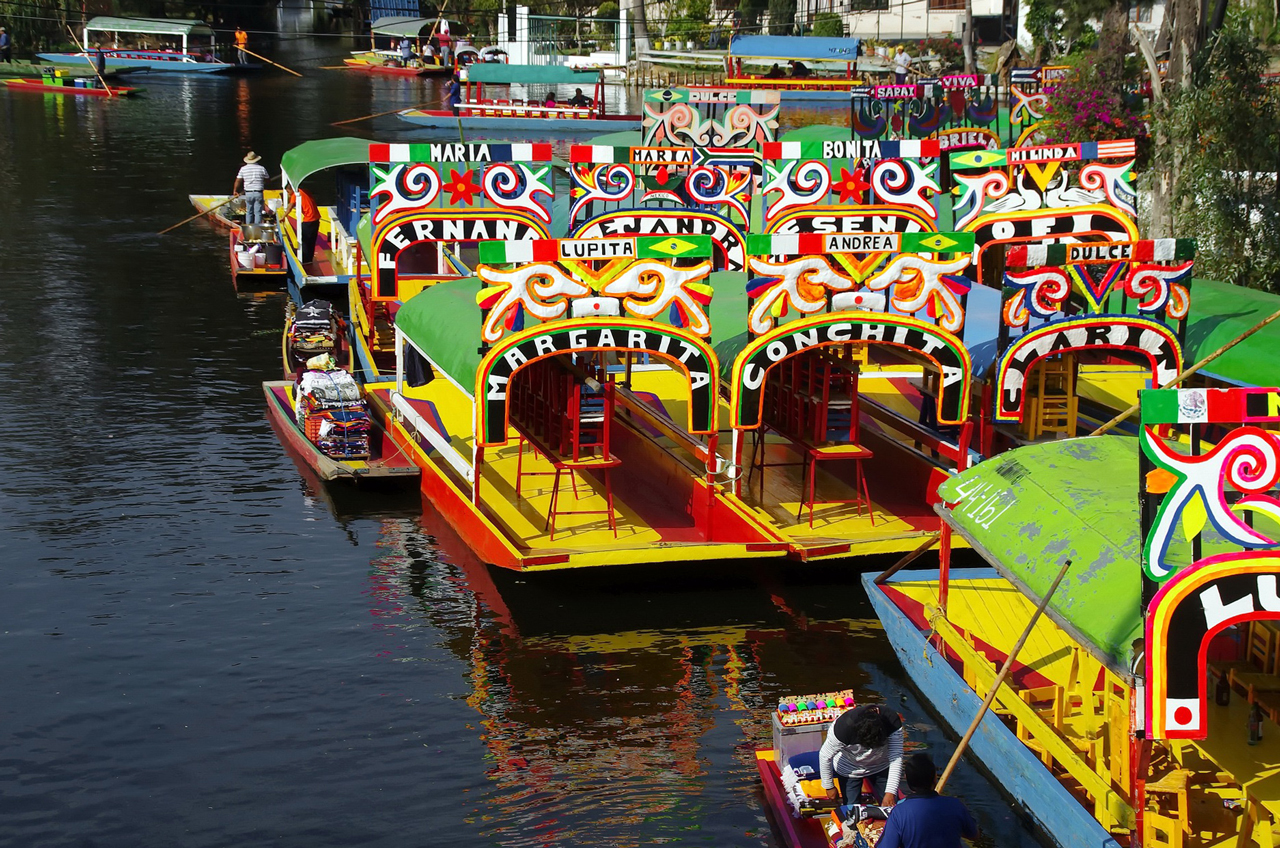
4.5 Visit San Andrés Mixquic: Mexico City’s Most Iconic Día de Muertos Cemetery
San Andrés Mixquic, a former village now part of the capital, is one of the few places in Mexico City where the tradition of Día de Muertos in cemeteries is still alive and well.
On November 2nd, families watch over their deceased all night in the panteón (cemetery), in an intimate, peaceful and respectful atmosphere. The graves are decorated with candles, cempasúchil flowers and offerings. Songs dedicated to departed loved ones are often heard, creating a powerful and touching moment.
Best Time to Visit Mixquic for Día de Muertos
Mixquic is a very popular venue during the Festival of the Dead, which can quickly become very crowded. To make the most of the experience, you have two options:
- For a livelier atmosphere: arrive around 8pm, but be prepared for the crowds.
- For a more peaceful atmosphere: dine first in the city (for example, at Casa de Toño, known for its affordable prices and fast service), then leave around 11pm, when the streets have emptied a little.
It’s an excellent option for discovering traditions at your leisure, with a local guide.
Book your visit to San Andrés Mixquic here:
How to Get to Mixquic and Where to Park for Día de Muertos
If you arrive before 10pm, you should be aware that the streets will already be very crowded, making traffic difficult even in the cemetery alleys. There are small pay parking lots nearby (cash only), but spaces are limited.
Another option is to hire a private driver – some of whom will wait on site to take you home later in the night.
Essential Tips for Visiting Mixquic During Día de Muertos
Although it may seem unusual to be in a cemetery in the middle of the night, the experience is exceptional – much better if you’re well prepared:
- Bring cash: everything must be paid for in cash, whether it’s food, drinks or parking.
- Keep your personal belongings at sight (phone, papers, money): Mixquic is generally safe, but as with any major event, vigilance is important in case of pickpockets.
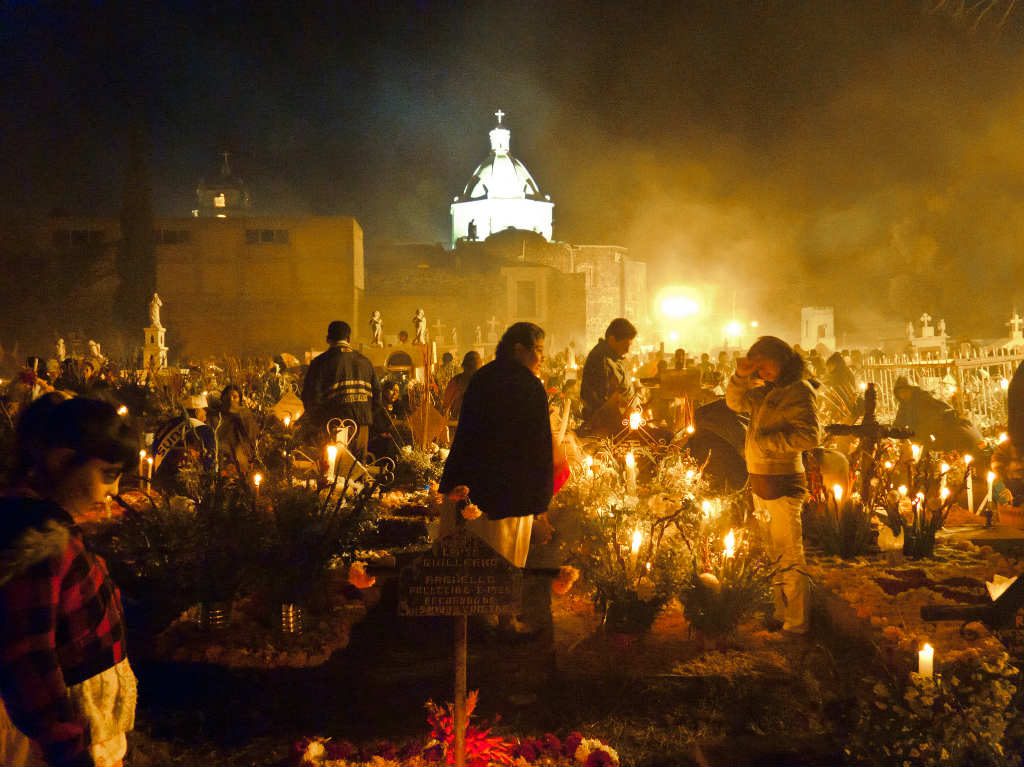
4.6 The Alebrijes parade
Organized by the Museo de Arte Popular, this parade features huge fantastical creatures known as alebrijes.
The procession departs from the Zócalo at midday, along Reforma Avenue to the Diana Cazadora fountain. The sculptures then remain on display for several days on Reforma.
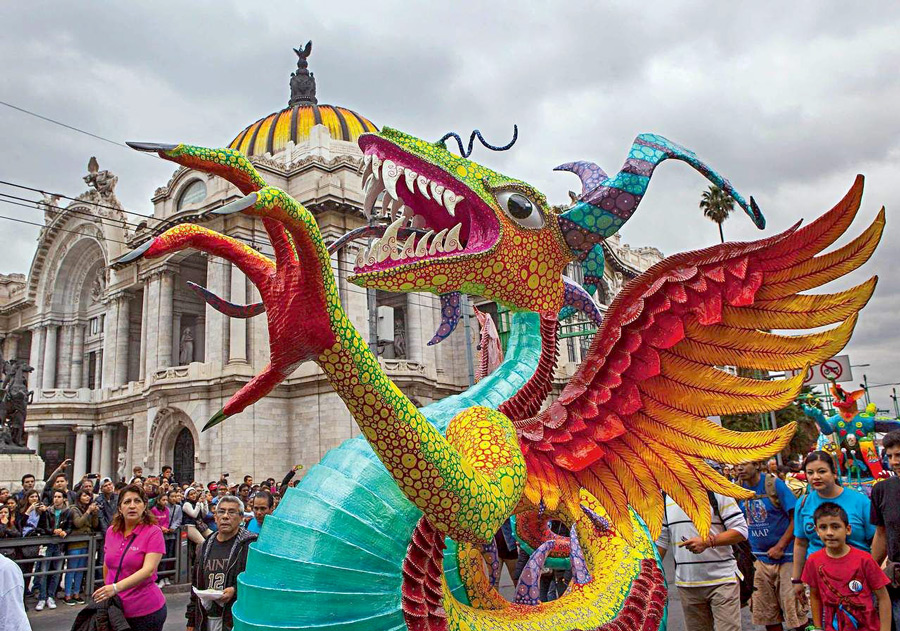
4.7 Discover the most spectacular altars
All over the city, altars (ofrendas) can be seen erected in public places, museums, schools, cultural centers, restaurants or even on the street.
Among the most impressive:
- Palace of Fine Arts
- The Coyoacán district
- The Kaluz Museum, which holds an annual ofrenda in its inner courtyard
- Museo Casa del Risco in San Ángel, famous for its elegant, traditional altarpiece
- Museo Anahuacalli
- The Zócalo, the large central square, with its monumental offrade surrounded by 27 altars created by different indigenous communities (recommended!)
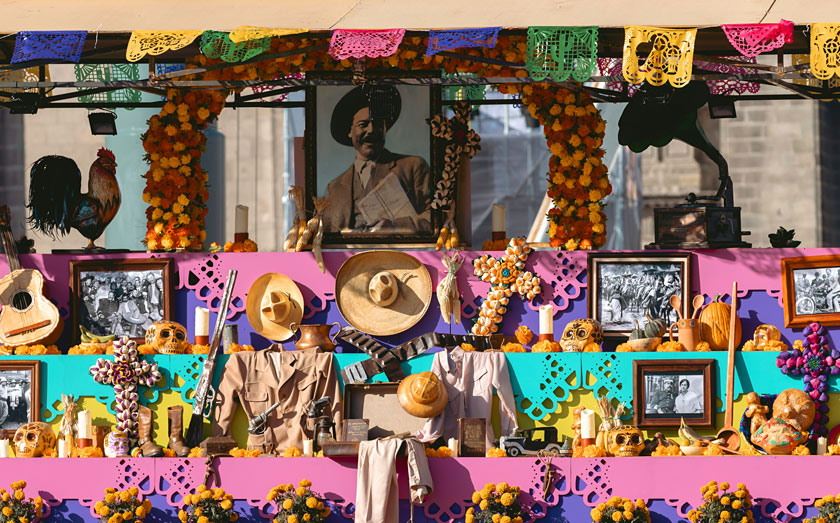
- The MAP (Museum of Popular Art)
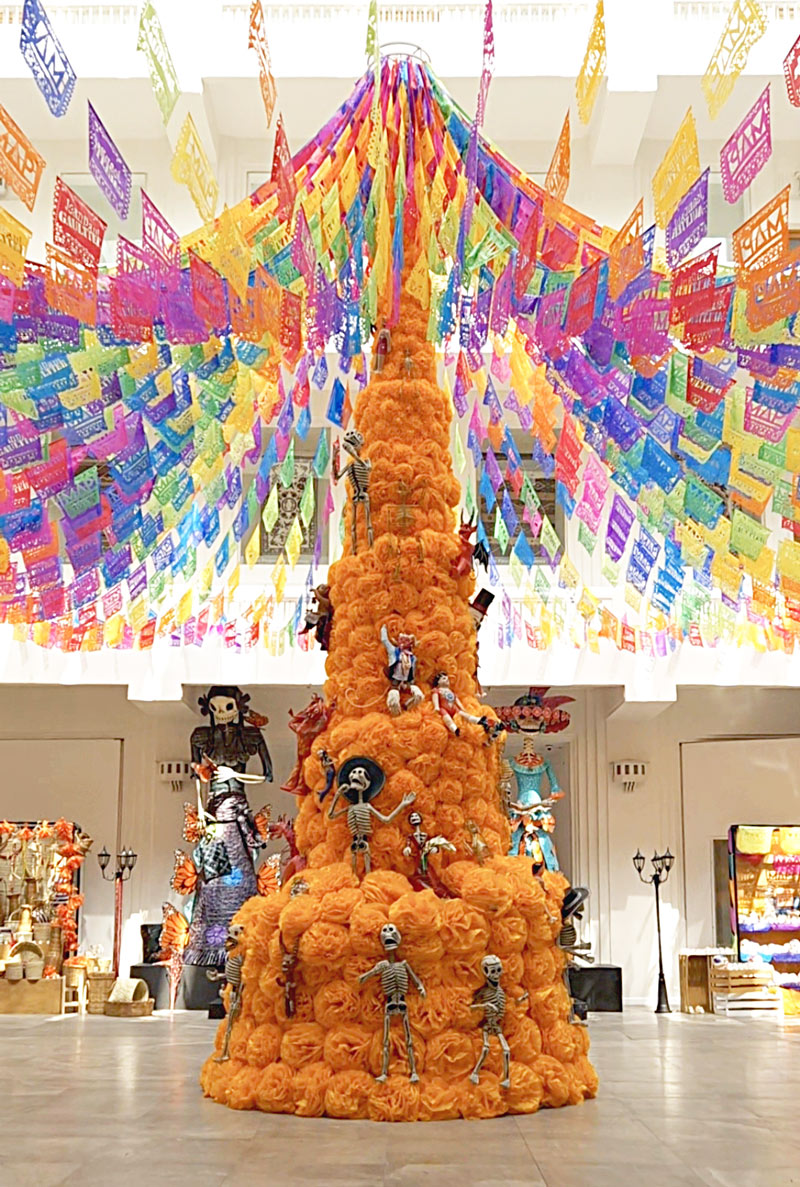
- La Casa de los Azulejos – a restaurant in an 18th-century residential palace. But you can go in without a drink, just to admire the place: it’s worth it!
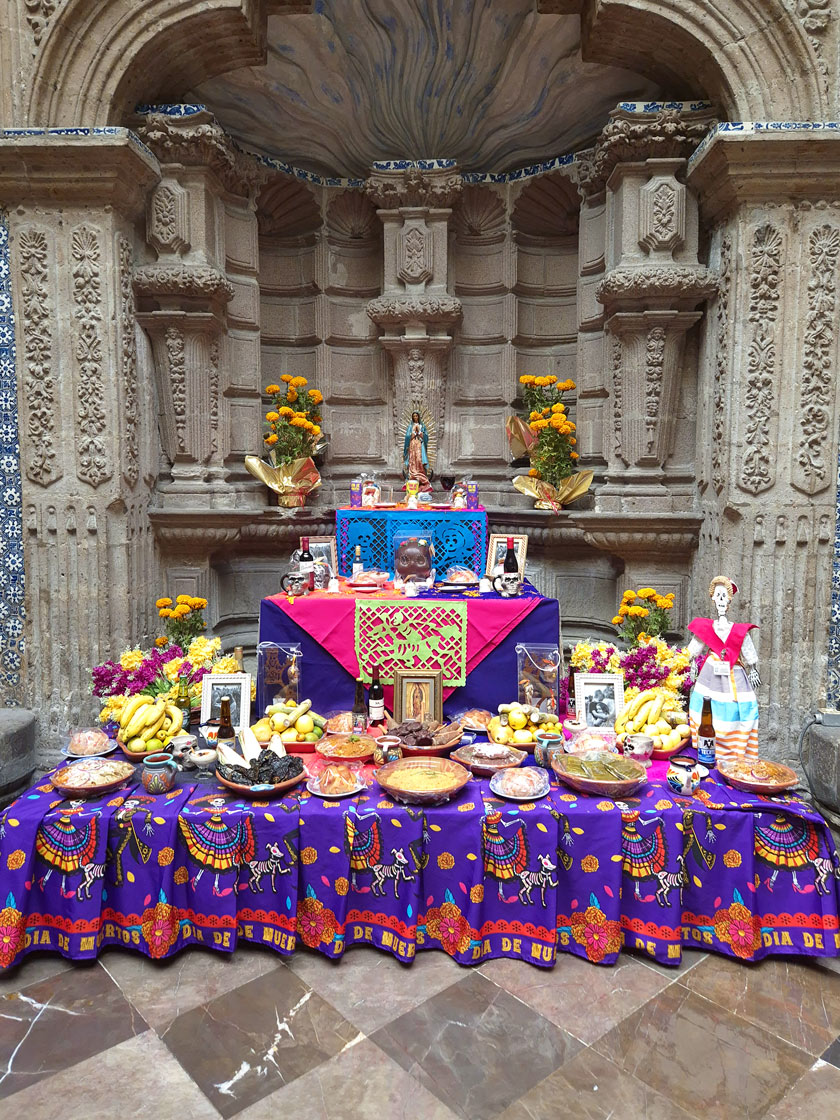
- Iturbide Palace – one of my must-sees in Mexico City’s historic center, this magnificent building houses a free museum
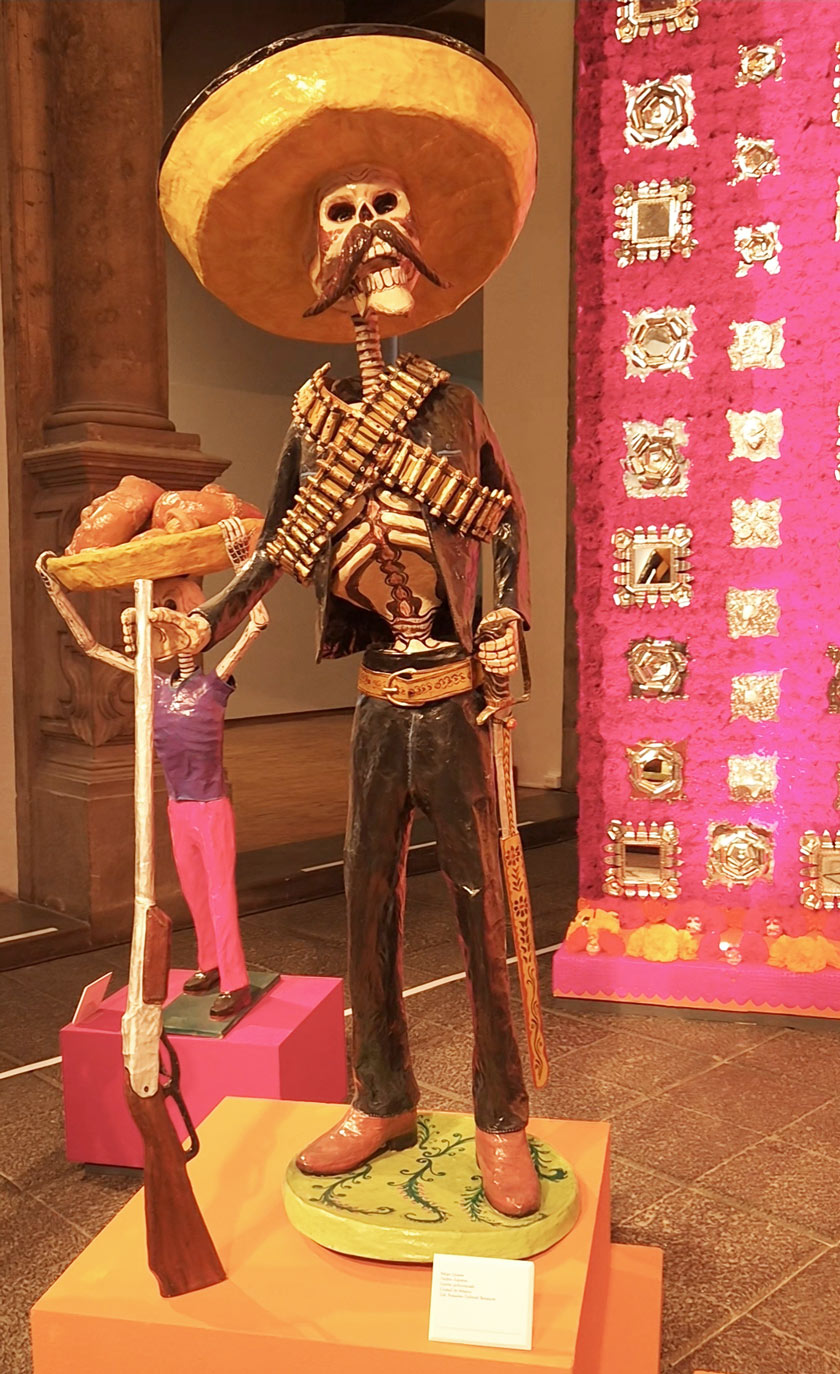
4.8 Discover Mexico City’s traditional markets
Mexico City has some fantastic markets to discover, and even more so at Día de Muertos time! They’re brimming with color, handicrafts, typical food and objects linked to the festive traditions.
They include:
- Candles, sugar figurines, fresh cempasúchil flowers
- Muerto bread, chocolate calaveras and many other specialties
- Masks and costumes for children and adults
Here are some of the best markets to visit in Mexico City during Día de Muertos:
- Jamaica Market: famous for its mountains of colorful flowers, perfect for decorations.
- La Merced Market and Sonora Market: two side-by-side markets, easily combinable, with a lively atmosphere and a wide selection of traditional objects.
- San Juan Market: located in the historic center, this market is famous for its exotic products, such as edible insects.
- Coyoacán Market: a smaller, quieter market in the Frida Kahlo district, ideal for discovering local crafts in a relaxed atmosphere.
Even without buying anything, I’d definitely recommend a visit during this period!
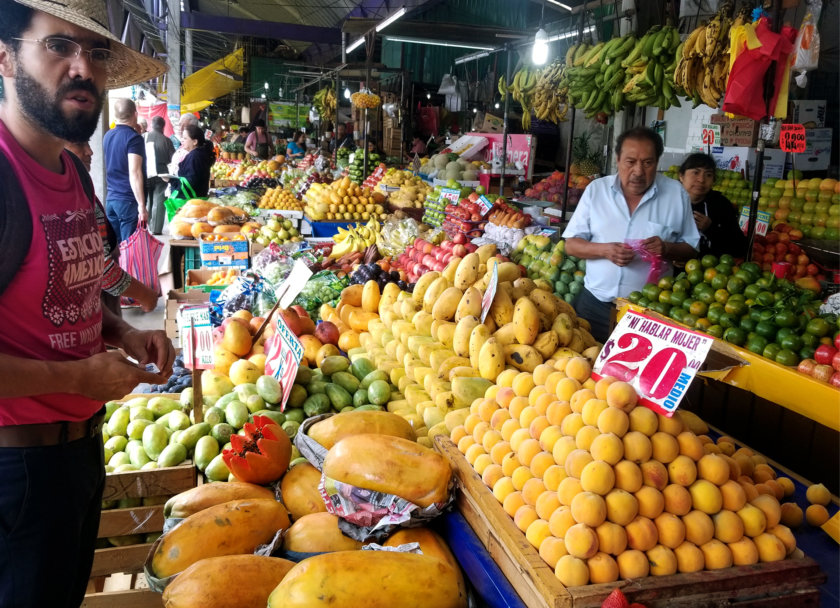
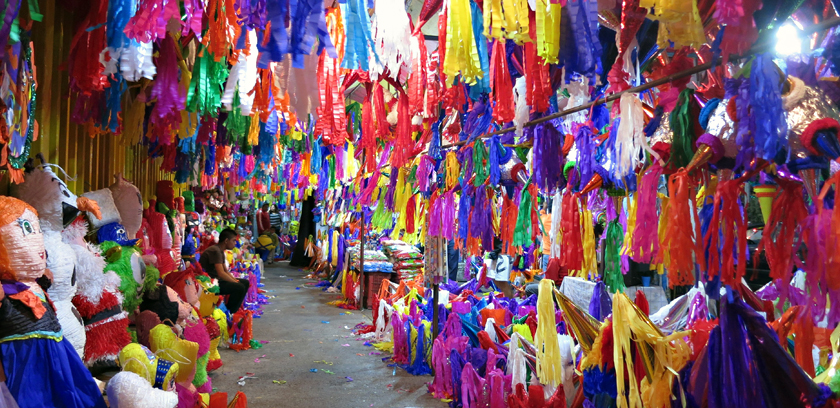
4.9 Visit museums with temporary exhibitions
To complete your stay, you can combine it with a cultural discovery.
Many of Mexico City’s museums organize special Dia de Muertos exhibitions every year, allowing us to learn more about Mexican history and discover original works, often combining contemporary art, crafts and history.
Here are a few museums not to be missed:
Kaluz Museum (downtown, near Alameda Central)
This private museum regularly presents a wide variety of temporary exhibitions, often focusing on contemporary Mexican artists who explore the themes of death, memory and ritual. The intimate atmosphere and meticulous scenography make each visit highly immersive.
Frida Kahlo Museum (Coyoacán)
Also known as the Blue House, this museum is dedicated to the life and work of Frida Kahlo. During Día de Muertos, it sets up altars dedicated to the artist’s memory and organizes special events that immerse visitors in the world of the Mexican painter, who was very attached to popular traditions.
To help you plan your visit, don’t miss my Complete Guide to the Frida Kahlo Museum (Mexico): Info, Tickets and Opening Hours!
If you’ve already booked your dates to visit Mexico City for the Festival of the Dead, you can also purchase tickets for Frida Kahlo here, or the full excursion to Xochimilco and Coyoacan
Museo Anahuacalli (Coyoacán)
Created by Diego Rivera, this museum houses an impressive collection of pre-Hispanic artifacts. On the occasion of Día de Muertos, it offers exhibitions celebrating the indigenous roots of this holiday, with art installations and traditional ceremonies in an exceptional setting.
Museo Casa del Risco (San Ángel)
Housed in a uniquely charming colonial house, this museum boasts a rich collection of Mexican colonial art and organizes a special Día de Muertos exhibition every year.
Its meticulously decorated inner courtyard provides the perfect photogenic backdrop for admiring the ofrendas (offering altars) and traditional decorations.
Museo del Carmen (San Ángel)
Housed in a former 17th-century convent, this museum is renowned for its religious art exhibitions and cultural events. During the Día de Muertos period, it often offers symbolic ofrendas and workshops to better understand the symbolism and history of this festivity.
4.10 Rodada Nocturna – nocturnal bike ride
Every year, a free bicycle ride is organized on Reforma Avenue (often the day before the big parade). Thousands of cyclists take part in this festive evening ride in costume, heading for the historic center.
5. Where to Stay During Día de Muertos in Mexico City
As in Oaxaca or Pátzcuaro in Michoacán, it’s imperative to book your accommodation as early as possible if you’re planning to experience Día de Muertos in Mexico City!
It’s one of the busiest times of the year, and accommodation often sells out well in advance.
To take full advantage of the festivities, I recommend staying in the historic center or near Reforma (where many of the big parades take place).
Another option is Coyoacán, if you like a more traditional atmosphere – although this district, located a little further south, is a little far from the big events. It is, however, very well decorated during the festivities, with numerous ofrendas.
And of course, Roma and Condesa remain pleasant central neighborhoods, a little quieter because the events don’t take place there directly.
Here are my suggestions for Dia de Muertos accommodation in Mexico City:
- Hostel Mundo Joven Catedral (historic center): one of the best hostels in Mexico City. Clean dorms and rooms, amazing rooftop terrace with bar, great atmosphere and an exceptional view over the cathedral and the Zocalo, starting at 15$usd for a dorm and 46$usd for a private room!
- Hotel Villa Condesa (Condesa): if you are looking for a romantic hotel in Mexico City, this is a little oasis in the heart of La Condesa. It is an elegant house with small green terraces and tastefully decorated rooms. Rooms are spacious, breakfast is very good and the service is particularly attentive. Around 160$usd per night!
- Casa Goliana (Roma Norte): high-end hotel with the best value for money in its category, located in an early 20th century house, typical of the Roma area. Rooftop terrace, comfortable rooms, very attentive staff, and good breakfasts. Around 325$usd per night
- Four Seasons Hotel Mexico City (Juarez): this 5 star hotel is one of the best hotels in Mexico City, ideal for a business trip or a romantic stay. Located on Paseo de la Reforma between Colonia Juarez and Roma Norte. A large indoor garden, gym, swimming pool, spa, restaurant, and bar, Around 640$usd per night!
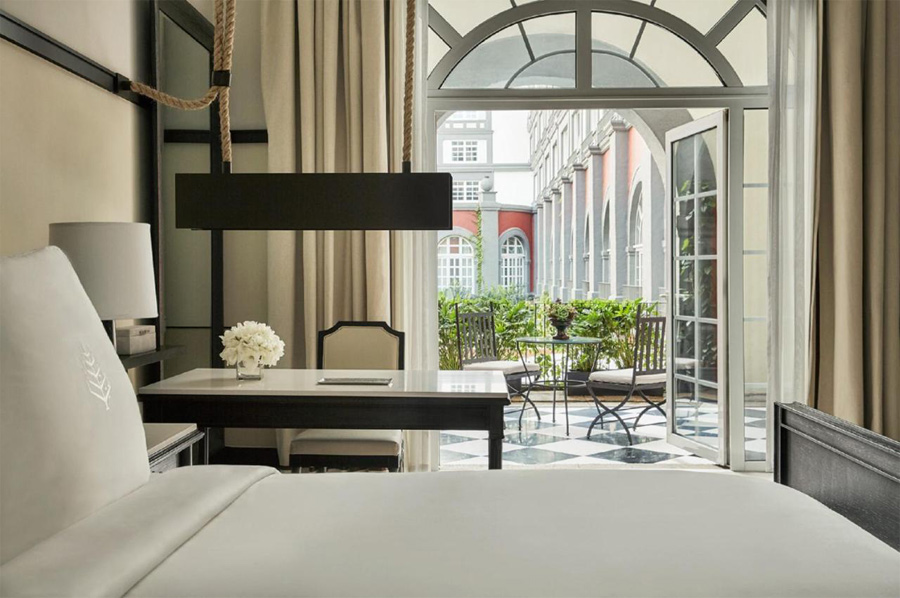
6. What to Eat During Día de Muertos in Mexico City (Typical Dishes)
Gastronomy plays a central role during Día de Muertos, and sampling local specialities is a great way to experience this traditional holiday to the full.
If you’re in Mexico City during this period, don’t miss out on the typical Día de Muertos dishes: you’ll find them in markets, bakeries, craft fairs and even in some museums.
6.1 Must-Try Traditional Foods for the Day of the Dead
During Día de Muertos, a number of traditional dishes are prepared to honor the dead and symbolically share a meal with them.
If you’re in Mexico City at this time of year, here are some of the typical specialities you’ll want to try:
- Pan de muerto: a slightly sweet brioche, scented with orange peels and decorated in the shape of a bone. There are several versions, sometimes filled with cream or chocolate. Served with hot chocolate!
- Mole: a rich, complex sauce, often prepared with chocolate, numerous spices and chillies, served with chicken or turkey, this is a festive dish much appreciated during the period.
- Tamales: made from corn dough stuffed with meat, vegetables, cheese or hot peppers and cooked in corn husks, these are a classic of Mexican cuisine.
- Atole: a thick, hot corn-based drink, often flavored with vanilla, cinnamon or chocolate. A perfect accompaniment to muerto bread.
- Dulces de calabaza: pieces of squash cooked in a sweet spiced syrup, a traditional sweet that is very popular at this time of year.
- Calaveritas de azúcar: small decorated sugar skulls, often given as gifts or placed on altars to honor the deceased.
6.2 Where to Eat Pan de Muerto in Mexico City
In Mexico City, there’s no shortage of places to enjoy a good pan de muerto: almost every bakery offers one during this period, and many cafés even create their own version for the occasion.
Here are a few of our favorites:
- Panadería Rosetta (Roma Norte): it must be said that the most famous bakery in Mexico City (made iconic by its popular guava roll mentioned in every travel guide) also makes an excellent pan de muerto, topped with amaranth or offered in an original version with totomoxtle (corn husk) ash.
- Palo de Rosa (Roma Norte): a small neighborhood café, slightly hidden, that serves a delicious, soft, traditional pan de muerto. It’s my favorite café in Mexico City because the staff is always incredibly friendly. 🙂
- Café Vegetal (Narvarte and Coyoacán): a 100% vegan bakery-café known for its ethical and creative pan de muerto. They offer different flavors like vanilla custard, chocolate, pumpkin spice, and everyone’s favorite: filled with homemade No-Tella.

7. Día de Muertos in Mexico: Words and Symbols You Should Know
To better understand this unique holiday, here’s a list of the essential Día de Muertos symbols and their meanings – you’ll come across them everywhere in Mexico City during this period.
- Cempasúchil: the emblematic orange flower of Día de Muertos, also known as the Indian rose. It symbolizes light and guides souls to the altar.
- Hummingbird: spiritual messenger, symbolizing the link between the living and the dead in certain indigenous beliefs.
- Pan de muerto (Dead´s bread): traditional brioche eaten during the festival. Each shape has a meaning: the “bones” represent the dead, the cycle of life.
- Calaveras: skulls made of sugar or chocolate, decorated and often humorously offered. They remind us that death is part of life.
- Altar (ofrenda): a space dedicated to the deceased, decorated with objects, flowers, food, photos and candles. Each element has a symbolic meaning.
- Papel picado: colored paper cut into decorative patterns, often hung above altars or in the streets. It symbolizes the wind and the fragility of life.
- Alfeñique: sweet paste used to make edible figurines and decorations, usually calaveritas.
- Ofrenda: literally “offering”, this is the altar set up to honor the deceased with personal objects, food, flowers and candles.
- La Catrina: elegantly dressed skeletal female figure, a popular Día de Muertos icon created by artist José Guadalupe Posada and popularized by Diego Rivera.
- Alebrijes: fantastic, colorful creatures, a mix of real and imaginary animals, sculpted or made from paper mache. They have become a symbol of Mexican folk art and are sometimes associated with protective spirits.
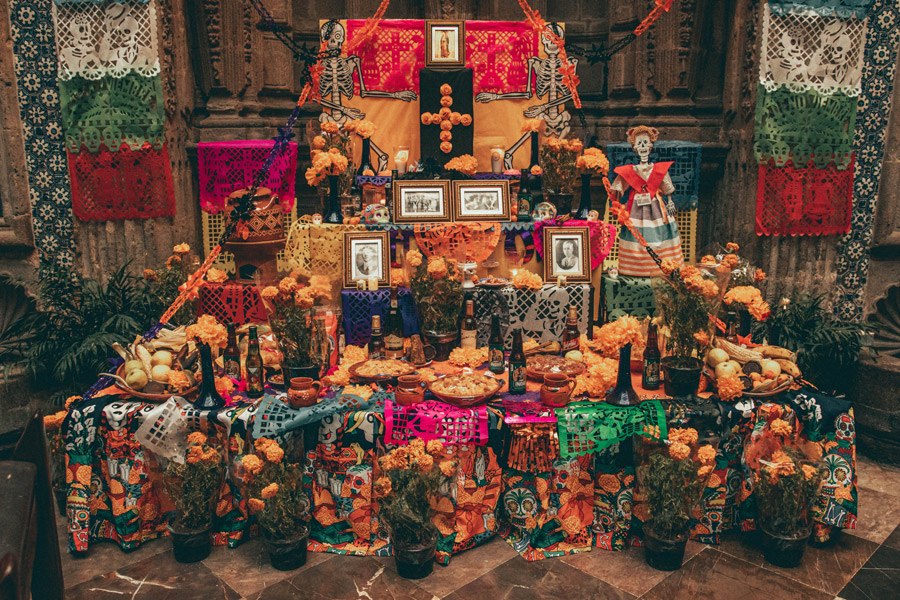
8. Best Neighborhoods to Visit in Mexico City During Día de Muertos
Some of Mexico City’s neighborhoods offer a particularly pleasant and authentic atmosphere during the Day of the Dead, with colorful decorations, small local festivals, artisan markets and a friendly atmosphere that invites discovery.
Coyoacán
A lively, family-friendly district, Coyoacán is the cultural heart of the city. During Día de Muertos, the streets come alive with craft stalls selling traditional decorations, handmade souvenirs and typical sweets.
There are beautiful offerings to be seen in the Jardin Hidalgo and at the Frida Kahlo House
Roma and Condesa
These two trendy neighborhoods are perfect for cosy cafés´ lovers, lively bars and contemporary art exhibitions.
During the period, several galleries and cultural spaces offer special events, art installations and performances around the Día de Muertos theme.
I suggest a trip to Pasaje El Parian (on Alvaro Obregon), on Calle Colima, and to Madre Cafe. They always have beautiful decorations for Día de los Muertos!
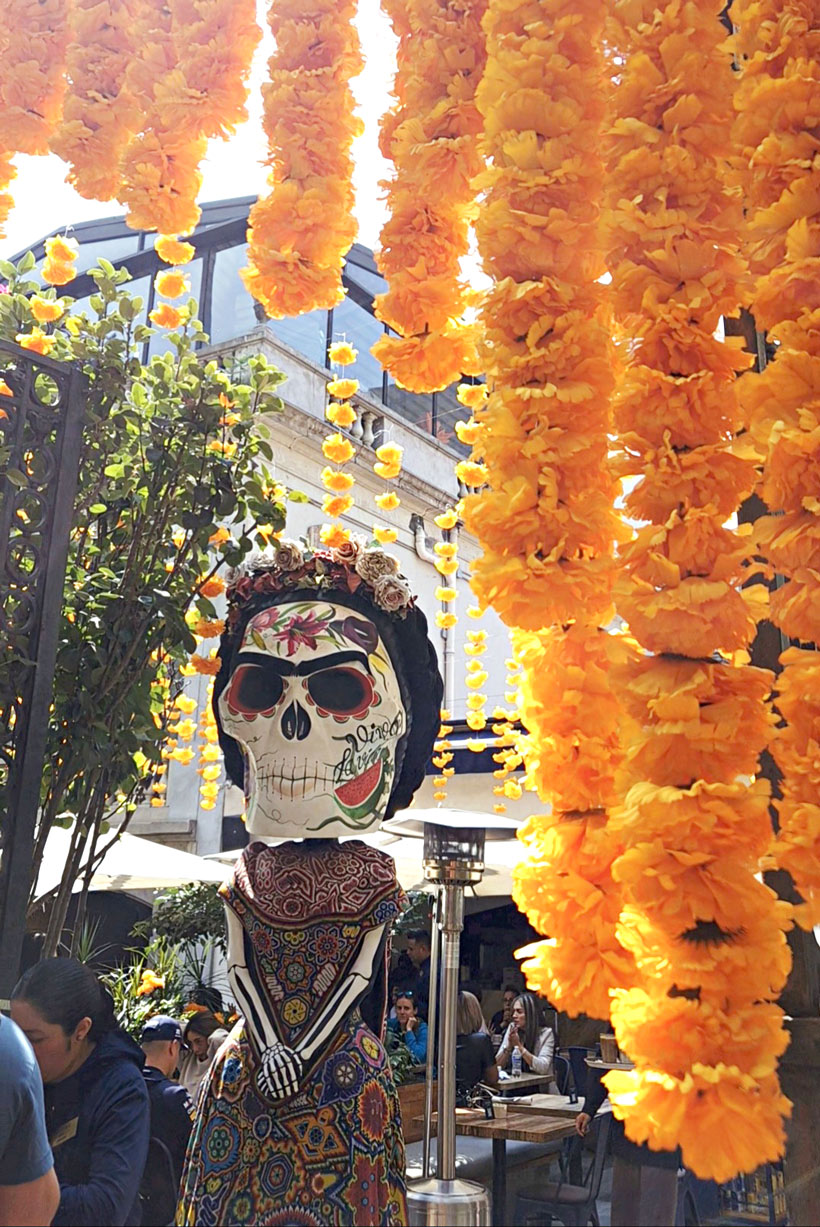
San Ángel
Renowned for its flower-filled patios, art galleries and well-preserved colonial houses, San Ángel is an ideal neighborhood for a quieter but equally immersive stroll.
Temporary exhibitions in local museums, as well as carefully crafted ofrendas in houses and public spaces, offer an elegant and traditional glimpse of the festivities.
Chapultepec
Around Chapultepec Park, one of the largest green spaces in Latin America, you’ll find a festive atmosphere with decorations in the gardens, as well as exhibitions and cultural activities in the nearby museums.
Of course, two must-sees are the National Museum of Anthropology and Chapultepec Castle!
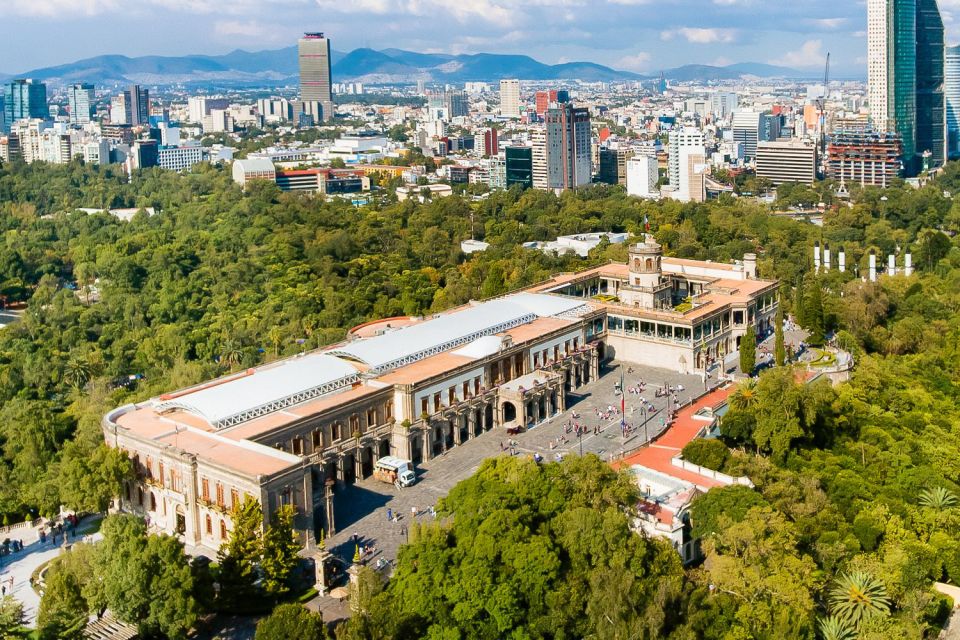
Reforma
Mexico City’s main avenue, Reforma, is also transformed during this period with art installations, public altars and street performances. It’s a must for Mexico City’s Festival of the Dead, as this is where the main parades take place!
Historic center
The historic heart of Mexico City is one of the most emblematic places to experience the Day of the Dead.
You’ll discover squares adorned with large public offerings, processions, artisan markets and traditional shows. The majestic colonial architecture and cobbled streets contribute to a unique atmosphere, where past and present meet around this ancestral celebration.
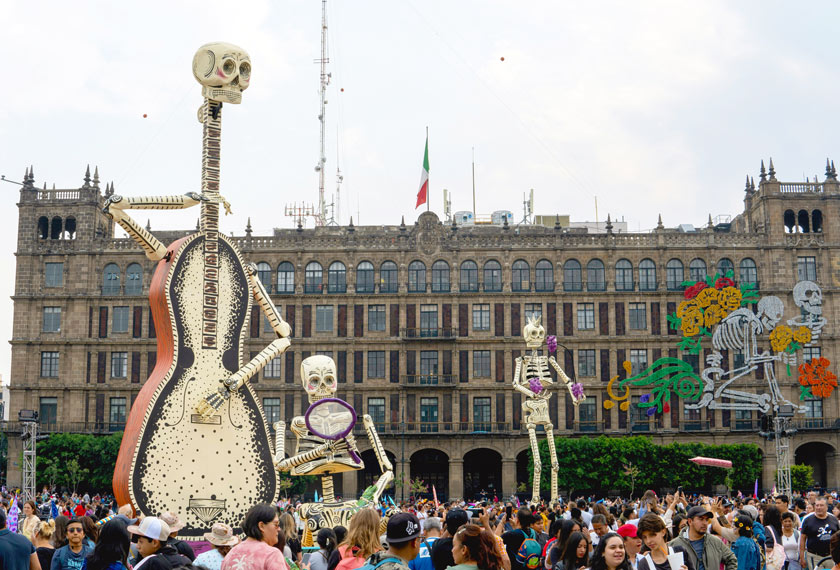
9. Suggested Itineraries for Día de Muertos in Mexico City
Mexico City is a big city, so it’s best to plan ahead.
To help you plan your stay during the Día de Muertos in Mexico City, here are my 3 suggestions for one-day itineraries.
Each suggestion allows you to discover a different aspect of this unique celebration: parades, altars, markets, cemeteries, trajinera or museums. To be adapted according to official parade dates and times (Catrinas, alebrijes, grande parade, Rodada Nocturna).
9.1 Historic Center: Altars and Parades in the Heart of the City
- Explore the large ofrendas set up on the Zócalo and around the cathedral.
- Visit the Kaluz Museum and its large outdoor ofrenda.
- Walk to the Alameda Central Park and Reforma avenue, places decorated for the occasion.
- Have your face painted and watch a parade, which often passes through Reforma on its way up to the Zócalo.
- End the day with a hot chocolate and a pan de muerto.
9.2 Coyoacán and San Ángel: Tradition, Markets and Local Art
- Discover the ofrendas in Coyoacán’s central square.
- Visit the Frida Kahlo Museum, often decorated for the festivities (tickets must be booked a month in advance via the official website).
- Pass through the craft market and sample local specialties (Coyoacán’s famous Café Jarocho with filled churros).
- Visit the Museo Casa del Risco in San Ángel to see its artistic altar.
- Visit the Dia de Muertos store, just off Plaza San Jacinto, where you’ll find all kinds of items related to the festivities
9.3 Xochimilco After Dark: Themed Boats, Music and Día de Muertos Vibes
- Take a trajinera ride in Xochimilco, with traditional shows depending on the date (sunrise options, cooking classes, cempasúchil field tours).
- Take a guided tour of the city’s legends.
10. Frequently Asked Questions About Día de Muertos in Mexico City
10.1 Is It Safe to Visit a Cemetery on Día de Muertos in Mexico City?
Yes, it’s safe. The atmosphere in cemeteries is family-oriented, respectful and joyful.
Even if you’re in a crowded place like Mixquic, just be mindful of your personal belongings, as you would in any large crowd. Keep your documents and phone safe, and avoid valuables. By following these simple tips, you’ll be able to enjoy a wonderful experience with complete peace of mind.
10.2 Can You Celebrate Día de Muertos in Mexico City With Kids?
Yes, of course it is!
Día de Muertos is a family holiday, and children are always welcome.
If you’re looking for something to do on Día de Muertos in Mexico City with children, you’ll find plenty of activities to suit them: colorful parades, spectacular altars in neighborhoods like Coyoacán or Roma, and even creative workshops in some museums or markets.
Many Mexican families come with their children, whether to watch the parades or visit the cemeteries during Día de Muertos, such as San Andrés Mixquic.
The atmosphere at Mixquic may impress or even intimidate some children, but rest assured that it’s warm, festive and respectful.
It’s important to always keep an eye on the younger ones, especially during big events like parades or in busy cemeteries.
There are lots of people, lots of noise, and sometimes little space to move around. But with a little organization, it’s a magical experience for the whole family – and a great way for children to discover another aspect of Mexico’s culture.
10.3 Can You Visit a Cemetery During Día de Muertos in Mexico City?
Yes, it’s an unforgettable Dia de Muertos experience.
Right in San Andrés Mixquic, where the tradition is still very much alive, families decorate the graves with flowers, candles and offerings, and watch over their dead all night long.
It’s a unique experience, comparable to that in Michoacán‘s cemeteries during the Festival of the Dead. It’s essential to respect the place and the families, not to walk on the graves, and to ask permission before taking photos.
10.4 What to Wear for Día de Muertos in Mexico City
The days are mild at this time of year, but evenings can be chilly, especially if you’re attending outdoor events or visiting a cemetery at night.
Bring comfortable clothes, a light jacket, good walking shoes and a raincoat or umbrella in case of rain. A headlamp or the one on your mobile phone can also be useful in dimly lit areas.
10.5 Where to Buy Día de Muertos Decorations in Mexico City
Mexico City’s traditional markets are the best places to buy typical Día de Muertos decorations.
The Jamaica market is famous for its mountains of colorful flowers like cempasúchil. The La Merced and Sonora markets, located side by side, are packed with figurines, candles, papel picado, masks and traditional objects.
And for a more relaxed atmosphere, don’t miss the charming Coyoacán market, perfect for discovering local crafts.
10.6 Are There Free Día de Muertos Events in Mexico City?
Yes, many free events are organized in Mexico City to celebrate Día de Muertos.
You can attend the grand parade on Reforma, admire the monumental altars in public places, visit temporary exhibitions in some free museums, or discover the entertainment in traditional markets.
If you plan your itinerary carefully, it’s perfectly possible to enjoy the festivities to the full without spending any money.
In fact, I recommend that you also read my articles:
- Mexico City: Ultimate Guide to the 40 best free activities!
- Mexico City on a Budget: Guide + My money-saving tips
Rent a car in Mexico City
Renting a car is for sure the best way to explore Mexico and make the most of your stay!
While it’s not super useful to visit the city, having a car is a must to discover the rest of the country.
To rent a car, personally, I always use Booking.com Cars, for a few reasons:
- You can easily compare the rental cars prices between all the agencies: for sure the easiest way to find the best rate!
- Cancellation is often offered free of charge: no need to worry if you change your mind
- Booking Cars offers full insurance coverage at a lower price than the rental companies, so it’s an instant saving with no effort
Simply click on the green button to find your rental car at the best price:
How to find the best price for your flight ticket
Mexico City Airport officially named Benito-Juárez International Airport receives a lot of national and international flights. It is the most important airport in Latin America!
To save money on flight tickets, you can use our flight comparator for Mexico, in partnership with Skyscanner: it’s the guarantee to pay the best price for your international and domestic flights!
🚗 Rent a car
🗽 Book entrance tickets and guided visits
🏄 Book your sports activities
🌍 Take a travel insurance
🙎 Book a tour
✈️ Book your flight
You’re traveling in Mexico? These articles will help you!
Discover all my articles about Mexico: All my articles to help you plan your trip to Mexico are listed there.
The 35 Best Things to Do in Mexico
- Day of the Dead (Mexico): How to Celebrate Día de Muertos Like a Local
- Day of the Dead in Michoacán: Best Places to Visit and How to Plan Your Trip
- Mexico City: The 31 Best things to Discover
- 1 Day in Mexico City – How to spend just 24h in the Mexican capital
- 2 Days in Mexico City – The perfect itinerary for 48h!
- 3 Days in Mexico City – The Best Itinerary + Where to Stay
- 4 Days in Mexico City – Your Four-Day Must-See Guide
- Where to stay in Mexico City? – Best areas and hotels for all budgets!
- Mexico City on a Budget: Guide + All my Best Tips to Save Money
- The Definitive Guide to 40 Best Free Things to Do in Mexico City
- World Cup 2026 Mexico: Guide, Tickets, Stadiums + Tips
- Anthropology Museum (Mexico City): Tickets & Must-Know Tips
- Teotihuacan (Mexico City): The Definitive Guide + Tips
- How to Visit Xochimilco (Mexico City): The Ultimate Guide
- Coyoacán (Mexico City): the Best Things to Do in Frida Kahlo’s Neighborhood
- Frida Kahlo Museum (Casa Azul): Info, Tickets and Opening Hours
- Lucha Libre in Mexico City (Tickets, Venues, Tips & More!)
- 40+ Wifi Cafes in Mexico City that Every Digital Nomad Should Know About
- Itinerary: 8-10 days in Mexico – From Mexico City to Oaxaca
- Itinerary: 10 days in Mexico – Mexico City, Chiapas and Yucatan
- Itinerary: 2 weeks in Mexico – Best itinerary to discover the Yucatan Peninsula and Chiapas!
- Itinerary: 3 weeks in Mexico – Mexico City, Puebla, Oaxaca, Chiapas, Campeche, Yucatán and Riviera Maya
- Itinerary: 1 month in Mexico – My Epic 30-31 Days Itinerary from Mexico City to Cancun
- Road trip in Mexico: The best itineraries for 10, 15, 21 days and a month
- Itinerary: 1 week in Yucatan – The Ultimate 6, 7 or 8 days Itinerary
- Itinerary: 10 days in Yucatan – Best Itinerary for 9, 10 or 11 Days in Yucatan
- Itinerary: 2 weeks in Yucatan – Epic Itinerary + All my Best Tips!
- Itinerary: 3 weeks in Yucatan – Best things to do in 20-21 days
- Itinerary: 1 month in Yucatan – Yucatan Peninsula in 29, 30 or 31 days from Cancun
- Road trip in Yucatan: The best itineraries for 7, 10, 15, 21 days and 1 month
You’re using Pinterest? Here is the picture to pin!






